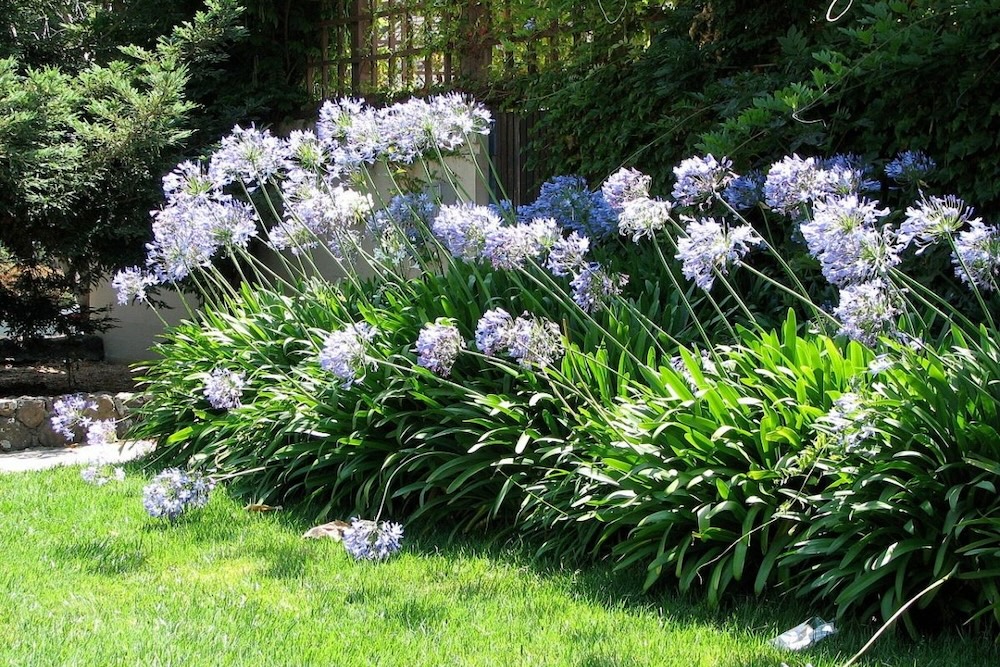Seasonal Agapanthus Treatment: Planning For Winter Months and Summer season
Wiki Article
Mastering the Art of Agapanthus Care: Essential Steps for Healthy Development and Vibrant Blooms
In the world of horticulture, the growing of agapanthus stands as a rewarding undertaking for those who seek to support these sophisticated flowering plants. With their striking flowers and elegant vegetation, agapanthus has caught the focus of gardeners worldwide. However, achieving optimal development and vibrant blooms needs a nuanced strategy that incorporates different vital actions. From selecting the right range to grasping trimming strategies, the trip towards growing growing agapanthus plants is multifaceted and holds the vital to unlocking the complete possibility of these agricultural treasures.
Choosing the Right Agapanthus Range

When picking the right Agapanthus variety for your garden, consider variables such as environment suitability, blossom color, and development habit. Additionally, consider the climate in your area to make certain the Agapanthus selection you choose can flourish in your certain problems. Recognizing the development practice of various Agapanthus selections is important for correct placement within your garden.
Perfect Planting Conditions
Thinking about the optimal environmental demands is essential for effective Agapanthus growing. Agapanthus prospers in well-draining soil with a slightly acidic to neutral pH level. When growing, pick a place that obtains full sunlight to partial color. In hotter environments, giving some mid-day color can stop scorching of the fallen leaves. Agapanthus plants are sensitive to chilly temperatures and must be secured from frost during winter season.To ensure healthy and balanced growth and vivid blossoms, plant Agapanthus bulbs at a deepness of concerning 2-4 inches and room them 8-12 inches apart. Mulching around the base of the plants helps preserve dampness and subdues weed development.
Watering and Fertilizing Tips
Keeping correct moisture degrees and giving crucial nutrients are crucial elements in the treatment regimen for Agapanthus plants. When it pertains to watering Agapanthus, it is vital to strike an equilibrium. These plants favor constantly wet soil yet are susceptible to root rot if overwatered. During the growing season, water deeply as soon as a week, ensuring the soil is well-draining to stop waterlogging. In hotter environments or during durations of dry spell, more frequent watering might be required to keep the soil evenly damp. Nevertheless, reduce watering in the winter to avoid water logged conditions.Fertilizing Agapanthus is vital for advertising healthy growth and prolific blossoms. Use a well balanced plant food, such as a 10-10-10 formula, in the you can try this out early springtime as new growth arises. Repeat this application every 6-8 weeks throughout the growing season. Avoid extreme fertilization, as it can lead to lush vegetation at the expenditure of blooms. Always adhere to the manufacturer's instructions for proper dilution and application methods. By adhering to these watering and feeding suggestions, you can guarantee your Agapanthus plants flourish and produce vivid, lasting blooms.
Pruning Techniques for Agapanthus
Pruning Agapanthus plants at the suitable times and with proper strategies is essential for maintaining their health and promoting optimum development and flowering. The excellent time to trim Agapanthus is in late wintertime or early springtime prior to brand-new development arises.Deadheading invested flowers can also redirect the plant's power into creating more blooms rather than setting seeds. If you want to collect seeds for breeding, leave some flowers to dry and mature on the plant.
Bear in mind to utilize clean, sharp devices to make precise cuts and reduce the threat of presenting illness. Agapanthus. Normal trimming will aid keep your Agapanthus looking neat and healthy while making sure a bountiful screen of gorgeous blooms
Dealing With Usual Bugs and Conditions
After making sure correct pruning techniques for Agapanthus, it is important to resolve common bugs and conditions that can affect the health and vigor of these plants. One usual bug that affects Agapanthus is the Agapanthus gall midget.Another usual problem is fungal fallen leave place, which provides as dark lesions on the leaves. To stop fungal diseases, discover this make sure excellent air flow around the plants, avoid overhead watering, and remove any type of infected fallen leaves without delay. In addition, Agapanthus plants can experience from origin rot if they are grown in poorly draining soil. To stop this, plant Agapanthus in well-draining dirt and prevent overwatering. By being watchful and taking prompt activity versus parasites and conditions, you can assist your Agapanthus plants thrive and create lively flowers.
:max_bytes(150000):strip_icc()/agapanthus-growing-guide-7368912_04-66a3f4cf245b4332b28954dd37c784f5.jpg)
Conclusion
Finally, understanding the art of agapanthus treatment entails selecting the appropriate range, giving optimal planting conditions, appropriate watering and feeding, appropriate trimming methods, and dealing with usual pests and illness. By complying with these important steps, you can make sure healthy and balanced growth and vivid blooms for your agapanthus plants. Remember to on a regular basis monitor and keep your plants to promote their general health and long life.To make sure healthy growth and dynamic flowers, plant Agapanthus light bulbs at a deepness of concerning 2-4 inches and space them 8-12 inches apart. By complying with these watering and feeding pointers, you can ensure your Agapanthus plants flourish and produce lively, resilient flowers.
One More Bonuses usual bug that affects Agapanthus is the Agapanthus gall midget. In addition, Agapanthus plants can endure from root rot if they are planted in improperly draining soil. By following these vital steps, you can make certain healthy growth and dynamic blossoms for your agapanthus plants.
Report this wiki page